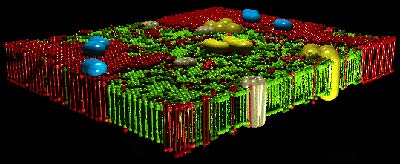Controversial New Idea: Nerves Transmit Sound, Not Electricity

Nerves transmit sound waves through your body, not electrical pulses, according to a controversial new study that tries to explain the longstanding mystery of how anesthetics work.
Textbooks say nerves use electrical impulses to transmit signals from the brain to the point of action, be it to wag a finger or blink an eye.
"But for us as physicists, this cannot be the explanation," says Thomas Heimburg, a Copenhagen University researcher whose expertise is in the intersection of biology and physics. "The physical laws of thermodynamics tell us that electrical impulses must produce heat as they travel along the nerve, but experiments find that no such heat is produced."
The textbooks are not likely to be rewritten anytime soon, however.
Roderic Eckenhoff, a researcher in the Department of Anesthesiology and Critical Care at the University of Pennsylvania School of Medicine, called the sound pulse idea interesting. "But an enormous burden of proof exists and they have a very long way to go to beat electricity," he said.
The olive oil clue
Nerves are wrapped in a membrane of lipids and proteins. Biology textbooks say a pulse is sent from one end of the nerve to the other with the help of electrically charged salts that pass through ion channels in the membrane. But the lack of heat generation contradicts the molecular biological theory of an electrical impulse produced by chemical processes, says Heimburg, who co-authored the new study with Copenhagen University theoretical physicist Andrew Jackson.
Get the world’s most fascinating discoveries delivered straight to your inbox.
Instead, nerve pulses can be explained much more simply as a mechanical pulse of sound, Heimburg and Jackson argue. Their idea will be published in the Biophysical Journal.
Normally, sound propagates as a wave that spreads out and becomes weaker and weaker. But in certain conditions, sound can be made to travel without spreading and therefore it retains its intensity.
The lipids in a nerve membrane are similar to olive oil, the scientists explain. And the membrane has a freezing point that is precisely suited to the propagation of these concentrated sound pulses [graphic].
Eckenhoff is not convinced, however.
"It is difficult to explain away an enormous number of real electrical recordings in the cell, tissue and whole animal as being some kind of artifact," Eckenhoff told LiveScience. "And I cannot easily discern how the sound might be generated."
Explaining anesthesia
The idea from Heimburg and Jackson, if it were proven true, could have implication for anesthetics, another mysterious process.
Oddly, scientists don't understand exactly what happens when a patient is anesthetized. While the goal of an anesthetic is to prevent the brain from feeling pain, the drugs can affect a patient's heart rate and breathing. So a better understanding of how it all works would allow development of better drugs.
Researchers do know that the proper doses of ether, laughing gas, chloroform and other anesthetics are all based on their solubility in olive oil. But how the nerves are turned off is a mystery.
Heimburg and Jackson offer an explanation.
If a nerve is to be able to transport sound pulses, they say, then the melting point of its membrane must be close to body temperature. Anesthetics change the melting point so that sound pulses can't propagate, they conclude. Nerves are put on stand-by and a patient doesn't feel the knife slicing into his body.
While Eckenhoff acknowledges there is much to learn, he expects the precise effects of anesthesia will ultimately be explained by an integration of current theories rather than by employing the new idea of sound pulses.
- Why We Itch
- The Pain Truth: How and Why We Hurt
- Fetuses May Not Feel Pain in Early Months
- Life's Little Mysteries
Robert is an independent health and science journalist and writer based in Phoenix, Arizona. He is a former editor-in-chief of Live Science with over 20 years of experience as a reporter and editor. He has worked on websites such as Space.com and Tom's Guide, and is a contributor on Medium, covering how we age and how to optimize the mind and body through time. He has a journalism degree from Humboldt State University in California.



